As early as now you may want to prepare (while it is not yet snowing out) a place in your land/field a garden for your flowers. You might want to consider having two separate gardens: one for perennials and another for annuals. The space should be rotatilled. Remove big rocks. Pull out all weeds and grass. Apply fertilizers (just check with gardening books and websites what sort of fetilizers are good for this purpose). Use compost if you have them. You might also want to get plant boxes for windows to display some annuals, which are usually short, or some pots for hanging or simply to be placed on the porch.
Sometime in spring you will have to plant the seeds. So get some tools: mainly potting soil, trays, fish emulsion fertilizer, waterer, heating pads, shelves and fluorescent lights. See how you will start your seedlings here:
http://www.geocities.com/lrg1212/gardening.html
I am sorry I can't give you an accurate time from planting the seeds to developing them into seedlings ready for transplanting into small pots as shown below.
These were the seedlings which we transplanted from the seedtrays...The trays this time were composed of 6 small pots per tray, which we placed side by side to fit into the trays. Prepare the soil by moistening again and placing them in each square box (be sure to make it compact enough so as not to shrink significantly when watered). When transplanting the seedlings, scoop out from the bottom of the soil to get a bunch of seedlings, then carefully separate the roots (don't wait too long as the roots might get so entangled that separating them might be difficult without severing, thus ending up with dead seedlings). Make sure that the square pots are
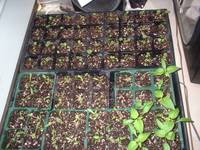 ready with moist soil before you uproot the seedlings from the trays. So, one by one, poke a hole through the soil in the small square pots, uproot a seedling from the tray, shoot into the hole deep enough, arrange the soil. Do this quickly and when done with a tray, water gently the soil so that it will seal around the roots. If this important step is not done, the roots will have no direct access to nutrients and moisture in the soil and will immediately die. Transplant as many seedlings as you would want to plant in your garden, making enough allowance for those which might not survive the trauma of transplanting.
ready with moist soil before you uproot the seedlings from the trays. So, one by one, poke a hole through the soil in the small square pots, uproot a seedling from the tray, shoot into the hole deep enough, arrange the soil. Do this quickly and when done with a tray, water gently the soil so that it will seal around the roots. If this important step is not done, the roots will have no direct access to nutrients and moisture in the soil and will immediately die. Transplant as many seedlings as you would want to plant in your garden, making enough allowance for those which might not survive the trauma of transplanting.
Keep them inside the house with plenty of light and heat (I am not sure what temperature is most appropriate, but I am guessing that simulating the heat of soil in the PHilippines, which is around 70-80 deg F, will be the optimum heat for the roots to grow). Keep them moist by watering daily. Prepare fish emulsion as directed and use this to water twice a week. Then during the latter part of spring wean the seedlings by slowly exposing them to the outside. If you have a greenhouse, it is better. Then finally transplant (lift our the whole plant with the potting soil) into the garden. As usual, water right after transplanting the whole square of soil into a whole in the garden soil. Water right away, everyday until you see that the plant has overcome the initial shock of transplanting (they look wilted initially. Don't lose hope. Keep watering them daily.) Remember to plant the tallest ones at the middle, the short ones nearer the border. Some types of grasses are also good as ground cover.
(Sorry that second and third part of gardening I forgot to document about because I had been busy too with my vegetable garden)
The following are photos of those plants the seeds of which I sent to you. (P) means perennial; (A) mean annual.
Asters - (P) MIL said they are wild. I liked them so I did not pull them out. Their seeds are like those of dandelions, and I guess they propagate the same way. Just try to scatter those seeds on a moist potting soil and keep them watered. Let's see if seedlings will come out. They grow to about 3 feet in height. Needs about 2-ft diameter space.

A purple-colored Aster

Astilbe -(P) probably nice to plant them in clusters like so...about 1-2 ft high. Need about 2 ft diameter space for the cluster.
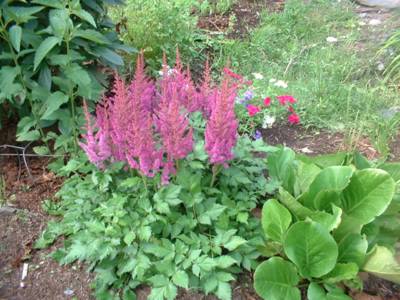
(P) I don't know the name of this plant, but they look like california blue bells. Look nice in clusters especially when all the flowers have bloomed. Bees like them so much (see the bee here flying towards the flower). Easy to propagate by dividing the cluster (just use a shovel to divide and reach a certain depth before separating the cluster in two). I tried collecting seeds (very few because the pods pop. It's hard to catch them becaause one day the pods are still quite green and not ready and the next day they have popped, all seeds scattered quite far away from the cluster. They grow to about one foot. Need planty of space if there are several plants in a cluster (about 3 ft diameter).

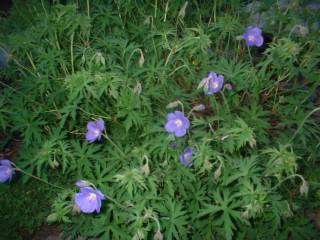
Columbines (P) are probably one of the prettiest flowers I have ever seen. Usually it is a combination of two colors like this (I had one that had a white and light yellow combination of colors).
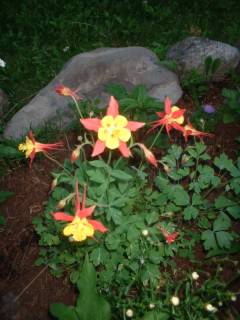
Or just one color like this purple one (I also saw a pure light pink plant, the seeds of which I also collected. They were growing wild at the side of the road, so I am not sure what color you will have. Those seeds are a combination of all the colors I saw here). They have the characteristic spikes pointing backwards, some are straight like the one above, or curved like the ones below.

These columbines grow to about 2-3 ft high, and may require 1-2 ft diameter of space.
Echineacea (coneflowers) (P) are prolific. Plant once and they easily scatter their seeds and propagate easily. Your problem will be how to control them from dominating your garden. They grow to about 3-4 ft high and you need about 1-2 ft space for them. You may plant them in clusters.

Foxgloves - (P) the seeds of which are so tiny and a pod contains about a million! Each cluster of flowers as you can see will give you many pods. Don't harvest all of the pods as birds love to eat the seeds during the cold weather. I had a foxglove which was there on the garden to start with and it bloomed during early summer or late spring, then this photo was taken of the foxgloves which I planted in early spring and bloomed late summer to fall. There are other interesting colors. The leaves reach about less than a foot high, but the flowers are about 1 ft additional.

Impatiens (A) will bloom even in shade and is perfect for borders of a garden or a walkway or around a tree or shrub. Less than a feet high. One plant will need less than a foot distance to the next. You may want to consider planting them in a box for windows or porch.

Lupine (P) are so grand-looking. Some have combination of pink-red or white red, some plain pink. Gives you many pods. Soak the seeds overnight or nick them somewhere at the ends of the seed. Grow to a height of 3-4 ft, one of the tallest plants in my garden. Need about 3 ft space.
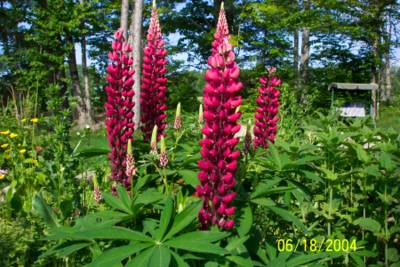
Marigold (A). Will bloom all thr0ughout summer to fall up to the first frost. NIcer to plant them close together in cluster in a plant box or pot, Nice to use to decorate your mailbox (put on top), very short (about 6 inches high).

Maroon daylilies (P) are also tall like the Lupines. Plant in clusters. Allow 2-3 ft space. I am not sure if this is a bulb plant, but I collected seeds from the pods. Just research some more.
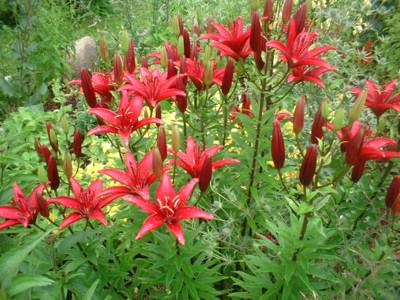
Pansies (P) are cute and small (there's a variety that a flower only measures about 1 inch diameter, but these are larger). The whole plant grows less than a feet tall. Nice on borders and in plant boxes or to surround your mailbox.

Petunia (A) looks like impatiens but with smaller and gentler flowers and stems, taller too. About 1 feet. Nice to plant close together (major stem of one plant about 5 inches from the other).
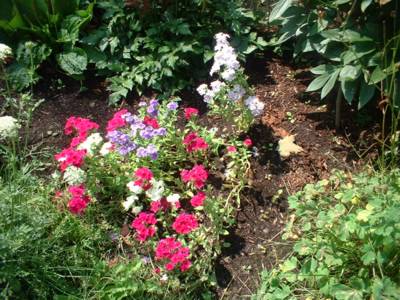
Purple passion (indoor plant). I am guessing that all indoor plants are actually tropical. I like them for their feathery maroon leaves. I took a cutting from my bilas' plant, removed several lowermost leaves, soaked it in plain water which I changed weekly until roots grew at the lower end of the stem. Then I planted on a pot. Then I noticed the flowers which were initially yellow, then turned to white, which I pulled to investigate, and saw that it was like the seeds of dandelions, so I sent you those. You can try planting them by scattering on moist soil and keeping them moist (you may use spray to keep them moist). See if they will grow.

Salvia red hot (A) are small but with such striking flowers. About 1 ft tall. Can be planted in a plant box, about 5 inches distance from one another.

Sedum (P) (late bloomer). Leaves look like roses themselves during spring. About one foot tall, with clusters of small pink flowers. I got pods from the dried flowers. Not sure though if they were fertilized and are actually ready to be planted. It might be that the frost killed the plant which thereafter wilted and dried up.
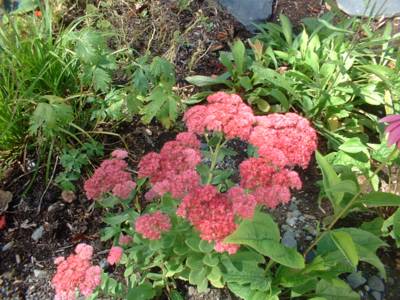
Snapdragon (A) are clusters of lovely flowers, the lower lip of the flower you can pull down and release then it will create a snapping sound, hence the name. Less than a feet tall. 1 plant can have so many stems. Put in nicely sunlit area.

This is a spiderplant. Strictly indoor. Easily propagated by the small plants that develop at those "galamays", but I got some seeds from fertilized flowers, which I sent to you in the hope that they can be propagated too using seeds.
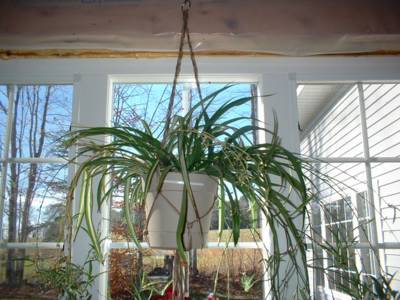
Sweet William Indian carpet...nice for borders. Less than a foot high. I am not sure whether this is an annual or perennial. I just got some seeds from my friend Ana's garden (we were not actually sure if there were seeds in the flowers. We were just guessing. Just try to scatter them lightly on moist soil or make a shallow groove and cover with just a little bit of soil.)
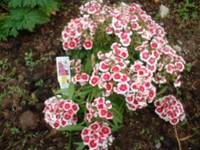
This indoor plant is unknown to me. It is peculiar in that it develops seedlings at its leaves! I forgot to mention (yata) in my package that you should try planting them right away by putting the seedlings on a moist soil and keep them watered (gently so as not to flood the seedlings or just spray generously) until the roots are established in the soil.
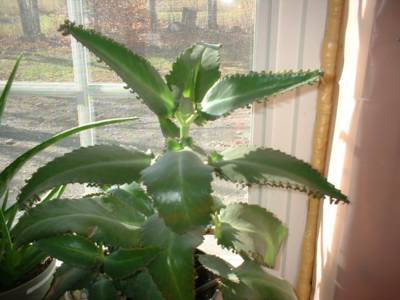
Another unknown annual to me (unk #2 in the package). I would guess that they love sunshine. Nice in a plant box or border or around a tree or next to a shrub or ferns. I vaguely remember having seen this kind of flower (also impatiens) in the Philippines when I was a child. Grows up to a height of about 1 foot.
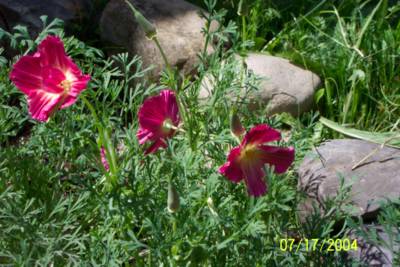

Other unknown flowers there in the package I have no picture of. (I forgot.)
Also the BES stand for Black-eyed Susan. There are actually varieties of it, some tall with smaller flowers, but the ones I sent to you have larger feathery leaves and larger flowers but the plant itself is smaller, 1-2 ft high only. Easily propagates itself.
Unk#1 are like tinier version of roses (the flowers) but with nice foliage a bit shaped like those of maple trees and without thorns. However, my cluster had very few flowers, and I am hoping that if I plant some of these seeds next spring I might have a new set of plants that might give me more flowers next year/s.
When you have a garden to look at during summer afternoons you will enjoy the busy buzzing of birds and butterflies and bees, ladybugs, and even grasshoppers! You have a pond so definitely you will have frogs there, who will feast on the insects visiting your flowers.
Better get a hold of some gardening book. You garden should have a variety of flowers that will give you different blooms all throughout spring to fall. Look for books which list those flowers (they differ from place to place). Then plan what you want to plant, putting flowers of different colors side by side. Order a catalog of seeds from one nearest you (we have here johnnyseeds) so you can order some more. You might also want to plant some trees like peaches, some shrubs like strawberry, raspberry and blueberry. I love making jams from them! But hubby said that with strawberries I will spend most of my time pulling out weeds, and that anyway, my in-laws already have patches of them and my bilas and sis-in-law are also planning to plant more. I can look forward to picking from their patches. These berries usually won't give you fruits for the first year or so.
Goodluck in your gardening endeavor! If you get some plants which I don't have, please save some seeds for me too. Just wait til the flowers are wilted, and keep watch of the pods of seeds. Get some before the birds eat them. (I collect mine into envelopes. You know those envelopes that usually come in promo mails, I don't throw them away. Don't keep collected seeds in plastic because they might perspire and then the moisture will encourage growth of molds.)
2 comments:
Hello Manang! Just visiting po. The photos are beautiful. I hope you don't mind my adding your blog to my list.
Manang! Thanks for the info and the link. :) You really are the best!
Jean
Post a Comment